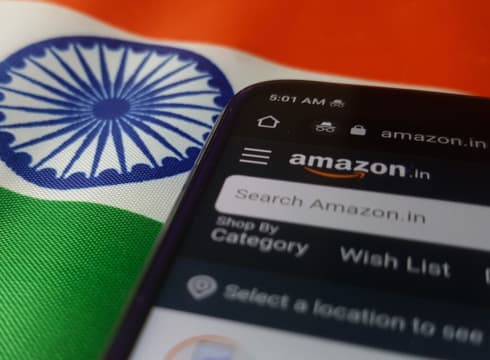Amazon is not only lagging behind its major Indian peers like Flipkart and Reliance but also new-age social commerce players like Meesho in various aspects: Bernstein
The reasons behind the lag are not straightforward but multi-fold and intertwined, including an unfavourable regulatory environment for foreign ecommerce players, the brokerage said
India has a low average order value of about $10, and Amazon has struggled to scale volumes in higher margin categories such as fashion and beauty and personal care
Inc42 Daily Brief
Stay Ahead With Daily News & Analysis on India’s Tech & Startup Economy
Profitability remains elusive for US-based ecommerce giant Amazon in India nearly a decade after its entry in the country despite an investment of over $6.5 Bn, brokerage firm Bernstein has said.
In a research report, Bernstein said that Amazon’s report card in the country is “decidedly mixed”.
Amazon is not only lagging behind its major Indian peers like Flipkart and Reliance but also new-age social commerce players like Meesho in various aspects, Bernstein analysts noted.
“Newer players like the Softbank-funded Meesho ($5 Bn GMV) are winning the faster growing Tier 2/3 cities where Amazon has struggled to gain traction given low pricing and ‘zero commissions’,” the analysts noted.
The reasons behind the lag are not straightforward but multi-fold and intertwined, including issues like Amazon’s weaker value proposition in ‘New’ commerce, limited traction in Tier II and Tier III cities, and an unfavourable regulatory environment for foreign ecommerce players.
Regulatory Issues
While Reliance Retail/JioMart has been driving scale with a first-party (1P) model, regulations don’t allow for an inventory-led/1P model for a foreign entity like Amazon, which uses a third-party (3P) model in the country.
India still has a less evolved seller ecosystem to execute a pure 3P model, while the 1P model provides the advantages of inventory control, pricing, and better customer experience, the report said.
“The regulatory market in India remains highly nationalised, prioritising local business over international entrants. Global marketplaces like Amazon are forced to run a marketplace structure in India charging commission on their platform (Amazon Seller Services),” it said.
Unable to operate and fully own a 1P business, Amazon has turned to acquiring minority stakes in local offline retailers like More, Shoppers Stop. However, integrations have been limited there also due to regulatory challenges.
On the other hand, its key competitor Reliance has scaled up its ecommerce operations, about 19% of core retail sales by utilising its strong footprint of stores and an inventory-led model, said the analysts.
Struggles Despite India Being The Fastest-Growing Market
Though India is one of Amazon’s biggest overseas markets and one of its fastest-growing markets with a best-in-class customer experience and large Prime customer base, it has come at a high cost of over $6.5 Bn that the company has invested in the country till date. All while profitability remains elusive, the Bernstein analysts said.
“Who can forget Bezos’ 2014 visit standing on top of a colorful lorry announcing a $2 Bn investment?” they said referring to the Amazon founder’s India visit.
Speaking further about the uncertainty about Amazon India reaching profitability, the research note said that India has a low average order value (AOV) at about $10. Besides, growth-related investments and profitability got impacted by a higher mix of low-margin product categories such as smartphones.
It is pertinent to note in this context that among its peers, Amazon leads in core categories like consumer electronics and media, and as the brokerage said, the company is estimated to have a leading 45% share in the smartphone category. In the media segment also Amazon has done quite well in Tier I cities with about 5 Mn prime subscriptions.
However, Amazon has struggled to scale volumes in higher margin categories such as fashion and beauty and personal care (BPC), where Flipkart (with Myntra) leads with the first category and Nykaa leads the second one, the report said.
“Amazon’s management attrition has also increased recently, potentially signaling difficulties achieving desired scale,” the analysts said.
“Despite the importance of the market, we estimate that it contributes <5% to Amazon’s overall value. At Amazon’s current valuation, we see the India business as a call option for Amazon investors, as long as the company is disciplined around capital allocation,” they added.
In the quarter ended June 30, 2022, Amazon’s international business reported a loss of $1.7 Bn. However, the ecommerce company said that it was still early days in many of its international businesses, including India, and it would continue to invest in these markets.
“To date, if we assume that Amazon has spent $7 Bn on fixed capital in India, it has a nice ROIC (Return on Invested Capital) set up, assuming a normalized EBIT margin in the LSD (low single digit) range on $20 Bn of GMV (Gross Merchandise Value),” estimated Bernstein.
The brokerage sees India as one of few large and under-penetrated ecommerce markets where ecommerce spending is expected to rise 2X to over $130 Bn in GMV by 2025 as online shoppers are projected to increase by 2X to about 300 Mn.
{{#name}}{{name}}{{/name}}{{^name}}-{{/name}}
{{#description}}{{description}}...{{/description}}{{^description}}-{{/description}}
Note: We at Inc42 take our ethics very seriously. More information about it can be found here.


